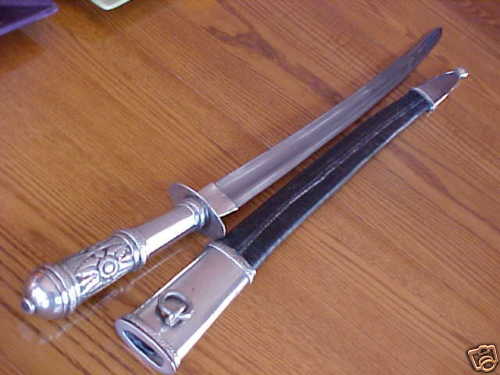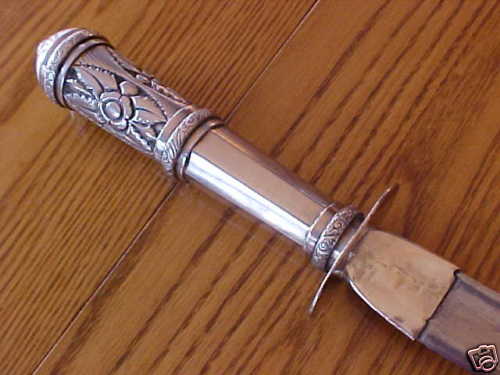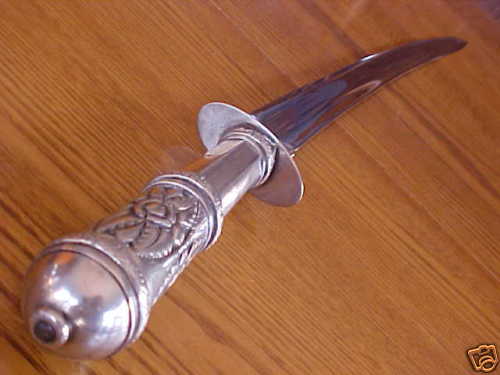Posts: 87 Location: NY
Thu 07 Apr, 2011 3:40 pm
| Quote: |
| Nice to see that new Spanish Bilbo among your other swords Carl. Can you tell me about the sabre that is 4th from the right? |
Hi Morgan,
I bought the hanger/cutlass 4th from the right for a steal at a show. It is ultra light an has a false edge. It was labeled as "Dutch" but according to Neuman's book it could be American from around the time of the Revolution. It loooks untouched and still has the original washer between the blade and guard.
| Quote: |
The biblo always struck me as being a rather strange choice of sword by the Spanish-it looks so awkward--but how does it handle?
Those broad/back swords are very nice--any information to share on those would be welcome. |
Hi Tom,
Every bilbo I have seen looks like it would be poorly balanced due to the small pommels, yet they have all surprisingly felt very light and well balanced This sword is no exception. I started a thread on it here. The consensus is that this bilbo was probably an officer's sword. The "NMN" on the blade stands for something along the lines of "Nomine..." a religious invocation. The sword feels great and weighs 2 lbs 3ozs.
There is a thread on the basket hilted brodsword here: http://www.myArmoury.com/talk/viewtopic.php?t...p;start=20
Apparently that, too may be a private purchase weapon, as the basket is of higher quality than the drury and jeffries ones. The blade is broad, with no fuller. The sword is 2lbs 7ozs.
The other basket hilt, all the way to the left, has the typical, rudimentary, mass produced government basket, but has a spadroon blade and the original shagreen grip. I showed this sword to George Neumann at a show and he was of the opinion that the blade was replaced during the 18th century with a spadroon blade and that everything looks right. He said that this was sometimes done if a blade broke, etc. I don't remember the weight of this one, but I can tell yout that it is so amazingly light that it feels lighter and better balanced than my singlestick and my Hanwei Pecoraro saber. The sword feels like it is made of balsa wood, not steel.
Posts: 515
Thu 07 Apr, 2011 4:31 pm
Here is a smallsword with a transitional hilt made my Dynasty Forge. They say it is no longer in production. A pity.
http://www.dynastyforge.com/index.php/Europea...flyer.html
Posts: 47
Thu 07 Apr, 2011 8:53 pm
Carl,
Thanks for all that information.
The bilbo looks a bit like a carribean type of rapier, so I can appreciate its fondness with the Spanish--even more so as you say they tend to handle well.
I think Mr. Neumann is correct about rehilted blades--we must remember that swords by their very nature were the object of repair and rehilting during their working lives--and that was during a time when things were recycled if still functional.
Posts: 515
Fri 08 Apr, 2011 10:19 am
| Tom Donoho wrote: |
Carl,
I think Mr. Neumann is correct about rehilted blades--we must remember that swords by their very nature were the object of repair and rehilting during their working lives--and that was during a time when things were recycled if still functional. |
And of course, it still goes on with swords today as well.
Posts: 515
Tue 12 Apr, 2011 1:04 pm
Posts: 125
Tue 12 Apr, 2011 1:34 pm
Hi Morgan,
Here's an accompaniment to your sword, a criollo dagger from the latter end of the 18thC. If you don't already know there is an expert and excellent paper, internet available, on these pieces by Abel Domenech who was kind enough to correspond with me regarding this particular knife.
Regards,
Norman.
 Attachment: 42.04 KB
Attachment: 42.04 KB

 Attachment: 33.83 KB
Attachment: 33.83 KB

Posts: 85 Location: UK
Sun 17 Apr, 2011 6:44 am
| Tom Donoho wrote: |
If possible, would you post a hilt shot of that cruciform spadroon--with the shell up and down, if possible. I am assuming that the blade is more or less like a regulation spadroon blade of the period. But the hilt fascinates me. |
Here you are Tom
 Attachment: 168.07 KB
Attachment: 168.07 KB
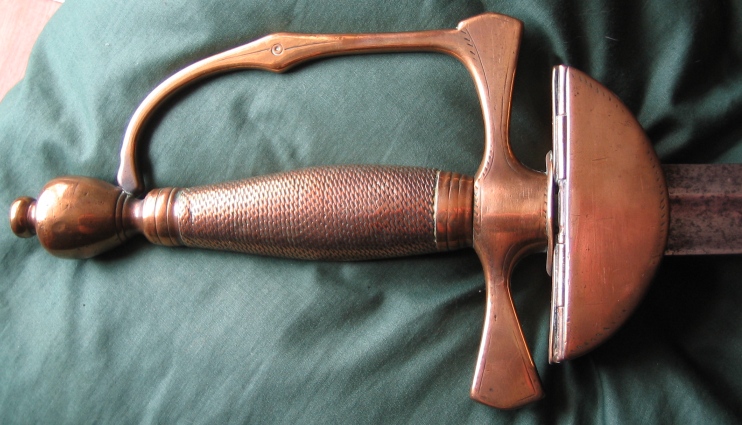
Posts: 229 Location: Tyrol, Austria
Sun 17 Apr, 2011 9:33 am
wow. is this a folding dish-guard before the cruciform hilt ?
Posts: 47
Sun 17 Apr, 2011 10:18 am
Yes, that is a folding guard.
Very nice!
I recall that a dealer had one of these 20 years ago or so. He wasn't sure what it was though--called it something else.
I just really like this one for some reason.
I like hinged shells--I enjoy seeing how they were locked into position--some appear as if the lock was added at a request from the officer as an after thought.
Morgan, do you like it?
Thanks for the photo, David.
Posts: 63 Location: Montreal Quebec
Sun 17 Apr, 2011 10:30 am
| D Critchley wrote: |
| Tom Donoho wrote: |
If possible, would you post a hilt shot of that cruciform spadroon--with the shell up and down, if possible. I am assuming that the blade is more or less like a regulation spadroon blade of the period. But the hilt fascinates me. |
Here you are Tom |
Thanks for the photo. This is a curious weapon. Any idea of the origin? At first (and second) glance, I have the feeling that the pommel is of older type than the hilt. This kind of piriform (pear shaped) pommel dates back to the late 17th to mid 18th centuries. It is strange to see this kind of rounded part on such a "flat" hilt. Intriguing.
D Critchley, do you have close up pics of the the hilt of the third spadroon?
http://farm4.static.flickr.com/3364/349926480...z.jpg?zz=1
It looks like older than the olthers: piriform pommel, "D" shaped bow rather than "stirrup" style. Thanks David
Posts: 85 Location: UK
Sun 17 Apr, 2011 10:35 am
| Gottfried P. Doerler wrote: |
| wow. is this a folding dish-guard before the cruciform hilt ? |
Yes, no lock on the guard though. Sprung with a leaf spring parallel with tang under the grip.
Thought to be the sword carried by the Honourable Artillery Company circa 1780.
 Attachment: 184.19 KB
Attachment: 184.19 KB
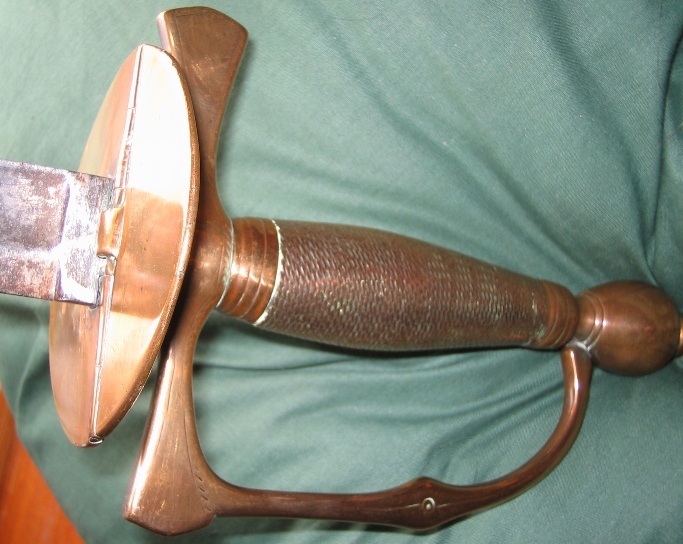
Pic 2
 Attachment: 185.43 KB
Attachment: 185.43 KB
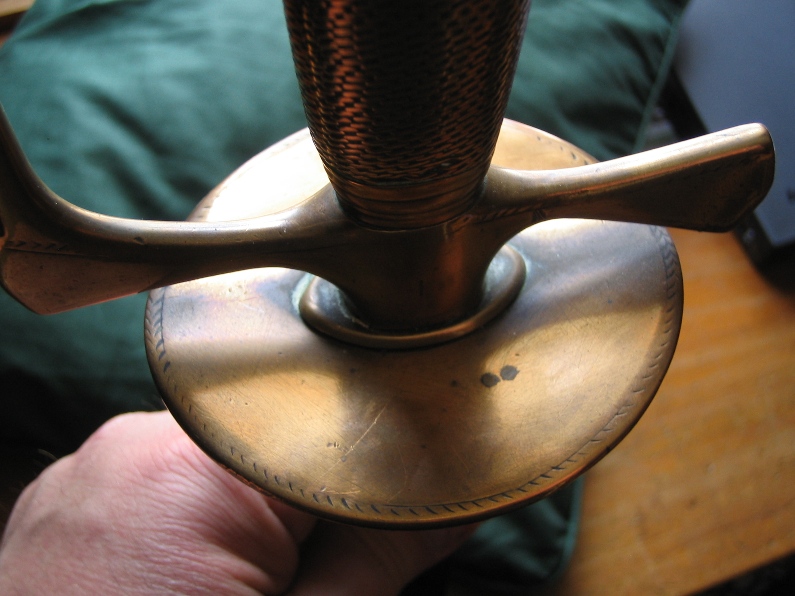
Pic3
Posts: 85 Location: UK
Sun 17 Apr, 2011 11:05 am
Here you are David, again a spadroon from the 1780s, with the 1786 regulation blade. Pre dates the 1796 pattern of a similar form
Plain hilt and ivory grip with plain fixed guards. The knucklebow is slightly distorted.
David
 Attachment: 131.57 KB
Attachment: 131.57 KB
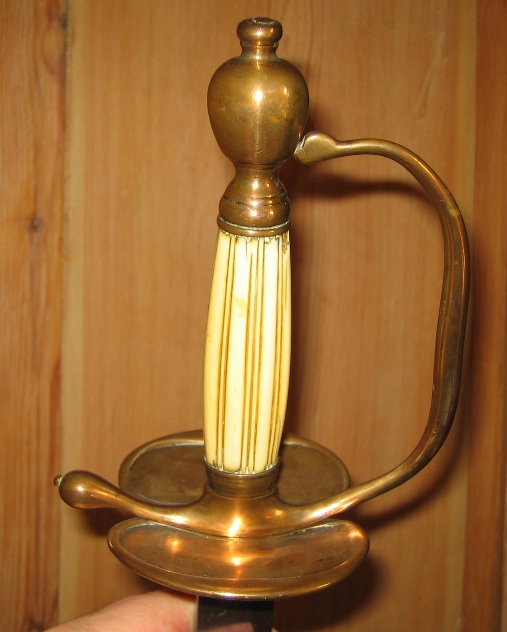
pic1
 Attachment: 110.92 KB
Attachment: 110.92 KB
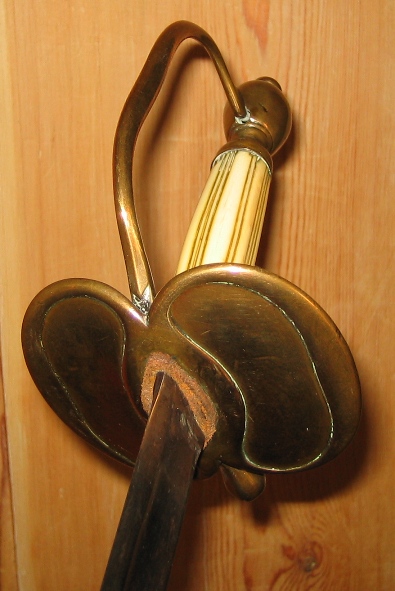
pic2
Posts: 47
Sun 17 Apr, 2011 11:21 am
Nice photos, David.
I assume that the artillery sword with the hinged guard would be an officer's weapon--I see remnants of engraved decoration to the hilt and that would suggest an officer, perhaps.
Posts: 47
Sun 17 Apr, 2011 11:27 am
I am watching the opera Don Carlos and checking in at sword sights--a nice part of the afternoon.
The production of Don Carlos showed backstage sword fight preparation--the rapiers are nicely done and the staged swordplay is nicely done, too.
:) :) :)
Posts: 85 Location: UK
Sun 17 Apr, 2011 2:24 pm
| Tom Donoho wrote: |
Nice photos, David.
I assume that the artillery sword with the hinged guard would be an officer's weapon--I see remnants of engraved decoration to the hilt and that would suggest an officer, perhaps. |
Yes I think so Tom, officer or sergeant. The ordinary gunner would probably have carried one of the styles of infantry hanger prior to about 1800 when the so called "Spanish Pattern is introduced"
Posts: 515
Mon 18 Apr, 2011 12:12 am
"Here you are David, again a spadroon from the 1780s, with the 1786 regulation blade. Pre dates the 1796 pattern of a similar form
Plain hilt and ivory grip with plain fixed guards. The knucklebow is slightly distorted.
David[/quote]
Tom- It is an interesting looking sword to be sure, but I think I like Spadroons with fixed guards better. They really do remind me of the English version of an Epee' Du Soldat.
David what is the difference between a 1786 regulation blade and a 1796 regulation blade?
Posts: 85 Location: UK
Mon 18 Apr, 2011 2:42 am
No difference at all Tom,
The 1786 regulations just specify the blade measurements and type, leaving the hilt up to the Regiment.
In 1796 the regs specified the whole sword introducing a 'new' standard hilt - although it was almost certainly one of the most common styles already in use by regiments - and restating the 1786 blade description to go with it.
At the same time they introduce the new Sergeant's sword variant, and then in 1802 further regs describe the Drummers variant.
David
Posts: 47
Mon 18 Apr, 2011 6:48 am
I am wondering when would be the earliest "proto-type" date for the pattern 1786 infantry officer's sword. I ask because Neumann's book has an example he attributes to the American Revolutionary War period. And I recall seeing in a catalog about 20 years ago 2 examples with turned wooden grips (in imitation of wire wrapping but no actual wrapping--grips looked original with patina and very good fit to the hilts) given a date of c. 1775-80. Would these have been for non-coms or junior officers, perhaps?
Posts: 515
Mon 18 Apr, 2011 1:05 pm
| Tom Donoho wrote: |
| I am wondering when would be the earliest "proto-type" date for the pattern 1786 infantry officer's sword. I ask because Neumann's book has an example he attributes to the American Revolutionary War period. And I recall seeing in a catalog about 20 years ago 2 examples with turned wooden grips (in imitation of wire wrapping but no actual wrapping--grips looked original with patina and very good fit to the hilts) given a date of c. 1775-80. Would these have been for non-coms or junior officers, perhaps? |
Here is a pic of the Prussian model that the British based the hilt on. Though I am always interested in seeing Pre-96 British versions of this swordhilt. (Because I hope a sword of mine might be one. ;) )
 Attachment: 30.08 KB
Attachment: 30.08 KB
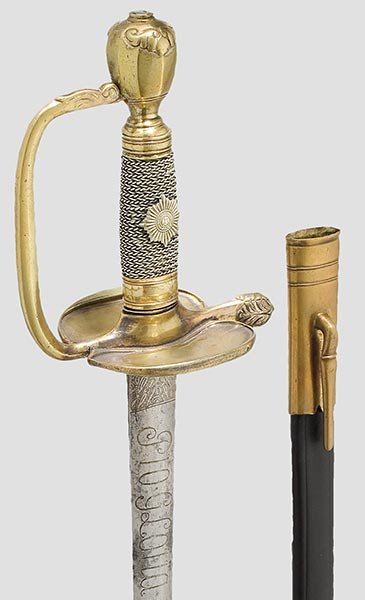
Posts: 85 Location: UK
Mon 18 Apr, 2011 3:01 pm
Yours may well be one Morgan, but I think it is impossible to say for certain. This style of hilt seems to originates in the Prussian army perhaps as early as the 1740s with and without pas d'ane . So it's quite likely that they appeared in England shortly afterwards as they did in Russia.
It's a broad rule of thumb that (discounting the 1796 Sergeant's pattern) the plainer the sword the earlier it is, also those fitted with diamond cross section blades also seem to be earlier. The vase shape to the pommel can also help to date the later ones. One can broadly apply the dating Aylward used for smallsword hilt shapes to this style of spadroon, it is after all really a militarised smallsword.
The hinged guard is no real help to dates as it is not a regulation facet. Hinged guards are unusual in pre 1796 but not unknown and there are plenty of fixed guard 1796s with post 1801 arms engraved on the blades. The hinged guard in all its forms (there are quite a few ways it is done), seems just to be a popular customisation that was tolerated but never formally approved in regulations.
Just to confuse things further, the 1st Regiment of Foot (Royal Scots), ignored regulations and fitted a broadsword blade to the 1796 hilt
David
You
cannot post new topics in this forum
You
cannot reply to topics in this forum
You
cannot edit your posts in this forum
You
cannot delete your posts in this forum
You
cannot vote in polls in this forum
You
cannot attach files in this forum
You
can download files in this forum
